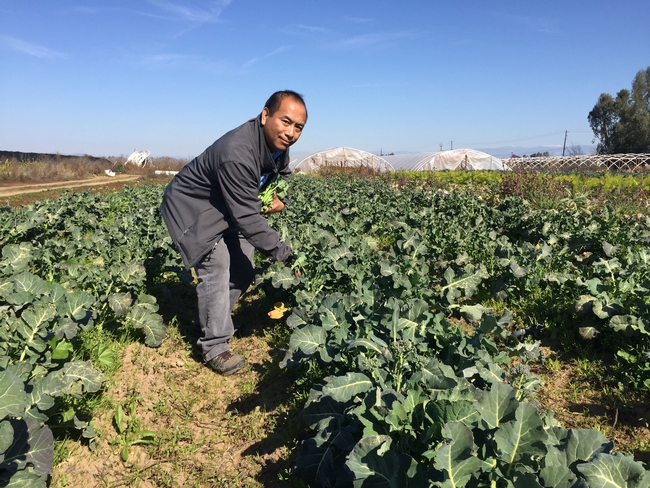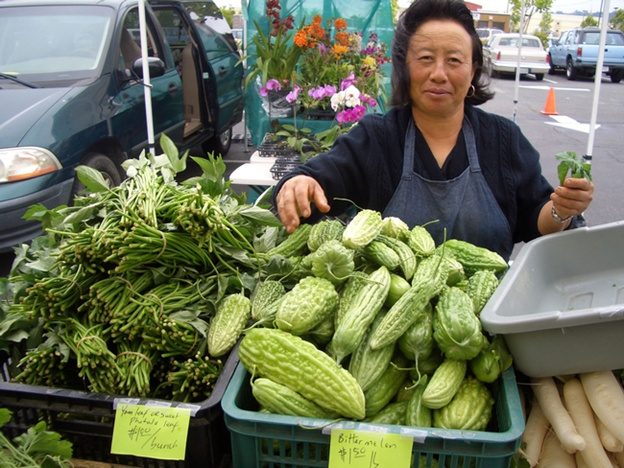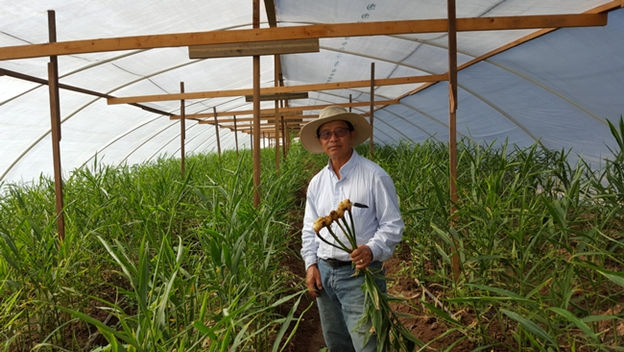
Hmong Resilience and Diversity in Agriculture and Food Systems

In this week’s seminar, Michael Yang and Lilian Thaoxaochay further explore the current context of AAPI community in the California food and agriculture systems, with a particular emphasis on Hmong immigrant perspectives. Topics discussed include a brief history of Southeast Asian refugee farmers, the lack of agricultural support these marginalized groups receive, the vast diversity of Asian crops, challenges that COVID-19 brought on, and the resilience these communities have in the face of adversity.
Michael Yang is a Second-Generation Hmong Refugee Farmer. He started growing cherry tomatoes and Asian vegetables in the mid-1990s. Michael joined the UC Cooperative extension in 1984 and is currently a Small Farms and Specialty Crops Hmong Agricultural Assistant in Fresno, CA.
Lilian Thaoxaochay is a First-Generation Hmong-American, descended from farmers for at least six generations back. She received her undergraduate degree in Medical Anthropology from Stanford University and her Masters's Degree in Southeast Asian agriculture at Santa Cruz. She is currently a Community Educator for UCCE Small Farms, Fresno.
Michael and Lilian’s brief description of the history of Southeast Asian farmers tells the story of how war and conflict led to people migrating from Southeast Asia to America. Lilian describes how the U.S. policy to distribute refugees to different communities to reduce the economic burden led to communities feeling isolated, so Hmong folks moved to California in the ‘80s to develop their own communities. As such, a majority of the farmers in Fresno, CA are of Hmong descent. Unsurprisingly, as with so many marginalized communities, the lack of federal funding and support for Hmong farming communities led members to depend upon each other for resources and such support.
The COVID-19 pandemic is one instance of recent adversity that immigrant communities in food systems faced. The vaccination process for farmworkers was especially difficult, with the language barrier, worker ID barrier, and confusion over vaccination information creating different challenges for each subset of people. Oftentimes, farmworkers had to rely on the younger folk in the community or those with access to English language education to receive their vaccinations and health information.
In addition, farmers are considered essential workers, but Southeast Asian farm operators are considered small businesses that don’t carry the same kind of insurance that larger companies do. As such, farmers' markets often become their livelihood. However, the language barrier is a challenge for many immigrant farmers that makes it difficult to sell at farmers' markets.

Despite these challenges, Hmong farmers and other Southeast Asian farmers are known for and able to grow such a wide variety of crops. These crops are oftentimes seen as unconventional due to their association with more tropical climates in Southeast Asia, but these farmers are extremely skilled, oftentimes without any formal training or education.
Michael and Lilian excitedly described the many delicious produce that Hmong farmers grow in Fresno, CA. Prominent crops include massive varieties of cherry tomatoes, squash, and so many gourds like sinqua and bittermelon.
Sinqua, or luffa, is known for its multiple uses. It can be used as food when its fruit is young, but it also has hard skin inside whose fiber can be used as an organic sponge for washing. Oboe squash is another example of a multi-use crop that can be eaten at a young stage but used as a water container when it matures.
A vegetable that cropped up frequently in discussions throughout the quarter’s seminars was bittermelon. They explained how the bitter taste is popular in Hmong culture because their culture believes that it has medicinal properties that help reduce cholesterol and diabetes.
It is believed that the older you get, the more you tend to like the bitter taste.
Once again, this demonstrates the importance of food as a remedy. It has benefits not only for physical conditions but also to foster that sense of community and relationship bonding that is associated with improved overall health.
At this point, discussion and input from the audience demonstrated how community members were able to relate to their love for these diverse crops that were prevalent in so many different cultures, but not usually found in mainstream supermarket chains.

Jujubes, guava, and moringa are three crops that these farmers are looking to shift towards as they are getting older and it gets harder to tend to row crops. These tree crops are also better at managing drought resistance. As more of the younger generations are becoming less interested in farm labor, aging farmers must take this into consideration as they seek to continue their livelihood.
There are exciting research trials being conducted on these diverse crops, and Michael and Lilian emphasize the importance of how their work allows them to support diverse farmers not often represented in the food systems community. These projects focus on breeding and crossbreeding crops to make them more resilient in the face of climate change and decreasing biodiversity, as well as preserving culturally relevant crops and breeding them for specific means, such as bitterness, shape, and size.
Lilian: “They think the way we started versus what we’re doing now has shown a lot of transition, innovation, without formal education, which is really fascinating and again we’re focusing a lot in Fresno County.”
A lot of the folk in immigrant farming communities are not school-educated and do not have a lot of capital to work with, but they are more than capable of growing so many amazing, delicious crops and sustaining a livelihood for themselves, their families, and their culture. Despite the many disadvantages that these marginalized communities face in the food systems, and in society in general, time after time has shown how resilient they are in the face of adversity. Similar to the crops like oboe squash and luffa they grow, these AA&PI farmers are resourceful despite whatever stage of life and environment they are thrown in. From violence and wars, to language barriers, to the COVID-19 pandemic, Asian American and Pacific Islander communities will prevail and flourish.
